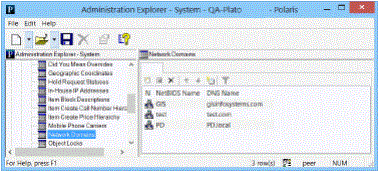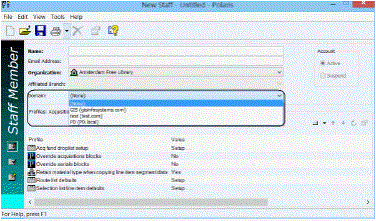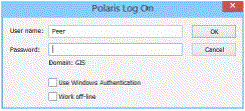Multi-Domain System Support
Polaris user (staff member) and workstation names in a single Polaris system do not have to be unique across a multi-domain environment. In the multi-domain environment, the workstation and staff member are associated with a domain in Polaris, and while the domain\workstation or domain\user combination must be unique, the workstation and user names themselves may be repeated as long as they are in different domains. You can choose to associate users with domains, workstations with domains, both, or neither. However, in a single domain environment, user and workstation names must be unique.
In Polaris Administration, use the system-level Database table Network Domains to specify the NetBIOS Name and DNSName for each domain in your network. For general information about adding and modifying table rows, see Working with Tables. The System Administration permission Modify network domains table: Allow is required to work with this table. If you leave this table empty, users and workstations must be unique.

The entries in this table appear as selections in Domain drop-down lists in the Staff Member and Workstation workforms, where the domain is selected from the drop-down list to associate the user or workstation with the domain. If no domains have been entered in the Network Domains table, the field is not available for selection.

Your settings also apply to staff client and ExpressCheck client log-on with a Terminal Server connection.
- Staff client Log On dialog box - The domain is displayed on the Polaris Log On dialog box. You can also enter a domain in the Name field; for example, Lib\Reid or reid@thelibrary.org.

- About Polaris dialog box - When you select Help, About Polaris on the Polaris Shortcut Bar, the About Polaris dialog box includes the user domain in the Polaris User field, and the workstation domain in the Polaris Workstation field.
- Web-based application log-ons - Polaris Fusion, Polaris Leap, Polaris Simply Reports, and Polaris WebAdmin log-ons require the domain in the user name field in the format username@domain or domain\username; for example, reid@thelibrary.org or Lib\Reid.
Network/Domain Requirements and Restrictions
Polaris recommends that the domain computer and user accounts are configured in Active Directory.
All Polaris Servers should be members of the same domain, or members of domains that include, minimally, a one-way trust. One-way trusts require that the application server be in the trustee domain. (For example, if domain A trusts domain B, the application server must reside in domain A, if domain A users are expected to use Polaris.)
An external domain controller can be used to authenticate users if the domain controller is trusted by the domain(s) in which the Polaris Servers are members.
If an application server is running in workgroup mode:
- When configuring a user account that is a member of the workgroup, leave the Domain field set to None in the Staff Member record.
- When configuring a computer account that is a member of the workgroup, leave the Domain field set to None in the Workstation record.
When configuring a workstation that has a NetBIOS name different from the DNS hostname, leave the Domain field set to None in the Workstation record.
When configuring a workstation that is also a Polaris server, leave the Domain field set to None in the Workstation record. The NetBIOS name of a computer running Polaris server-side software must be unique among all trusted domains.
- Each network domain configured in the Polaris Network Domains table must have a unique NetBIOS domain name.
- Each network domain configured in the Polaris Network Domains table must have a unique DNS domain name.
Remote desktop:
- If the staff client is run on a Windows terminal server via a remote desktop connection from a workstation that is a member of a trusted domain, then the remote desktop client workstation can be domain-specific.
- If the staff client is run on a Windows terminal server via a remote desktop connection from a workstation that is not a member of a trusted domain, then the remote desktop client workstation cannot be domain-specific.